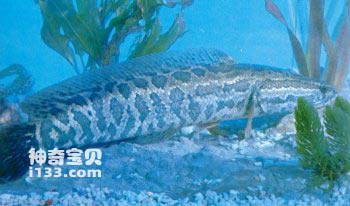Channa argus belongs to the order Perciformes, suborder Perciformes, family Channa, and genus Channa. Commonly known as: black fish, talented fish, mullet, black stick, snake head fish, raw fish. English name: Argus snakehead fish, Northern snakehead.
The body is slender, cylindrical in front and flattened in back. The head is pointed and flat, and the top of the skull, cheeks and gill covers are covered with scales. The mouth is large, end-positioned, and the lower jaw is slightly protruding. The upper and lower jaws, vomers, and oral bones all have sharp fine teeth. There is a wide suprabranchial cavity above the pharynx, which can breathe air. The bases of the dorsal and anal fins are large, and the caudal fin is rounded. The body color is dark, with many irregular black spots on the side of the body, two vertical and horizontal black stripes on the head side, and black and white stripes on the dorsal fin, anal fin and tail fin; the pectoral and pelvic fins are light yellow, and there is a black spot at the base of the pectoral fin.

Snakehead is a ferocious bottom-dwelling carnivorous fish. It usually likes to live in shallow water areas with dense aquatic plants on the muddy bottom along the coast. It lurks in the aquatic plants and waits for opportunities to hunt for food. It sometimes swims in the upper layer of the water at night. It swims slowly at ordinary times. In oxygen-deficient water, it can use the auxiliary respirator in the upper gill cavity to breathe with its head tilted above the water from time to time. A certain amount of gas is stored in the depression above the throat. They can survive for a long time after leaving the water body. In deep water in winter, they bury their bodies in mud to survive the winter, and generally eat little. Spring and autumn are the peak feeding seasons, and broodstock basically do not feed during the spawning period. They are ferocious in nature and the larvae feed on zooplankton; the juveniles feed on aquatic insects, shrimps and small fish; the adults prey on other fish. Snakehead snakeheads reach sexual maturity at 2 years of age and can carry 14,000 to 34,000 eggs. Broodstock breed from May to July in still water shoals with lush aquatic plants. The broodstock fish live in pairs at the spawning site and are very active and sometimes jump out of the water. The male uses his mouth to build a "fish nest" about 1 meter in diameter from aquatic plants. Before the quiet sunrise, the female fish first enters the fish nest, lies on her back with her belly upward, and slowly shakes her body to lay eggs; then the female fish ejaculates in the same way. After spawning, the male and female fish stay together under the nest to protect the eggs and prevent predators. After 2-3 days, the larvae hatch. The larvae live in clusters in the aquatic plants near the shore, and the male fish follow the group to protect them. When the juveniles grow to 4-5 cm, the parent fish no longer protect them, and the juveniles disperse and live independently. Snakeheads grow quickly, with the largest individual reaching 700 mm in length and weighing about 5 kg.
Snakehead is widely distributed. In addition to the western plateau area, this fish is found in rivers, lakes, reservoirs, ponds and other types of water bodies from Heilongjiang to Hainan. It is native to western and southern Korea abroad.
animal tags:
We created this article in conjunction with AI technology, then made sure it was fact-checked and edited by a Animals Top editor.